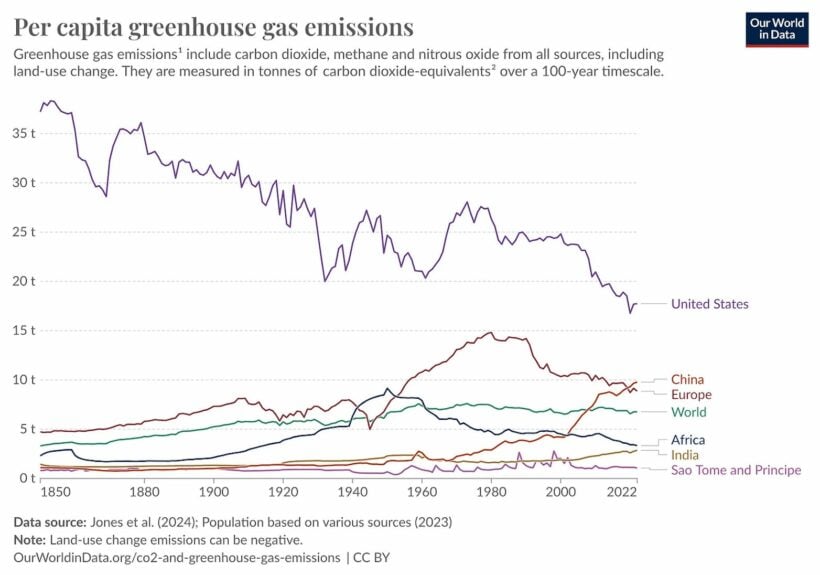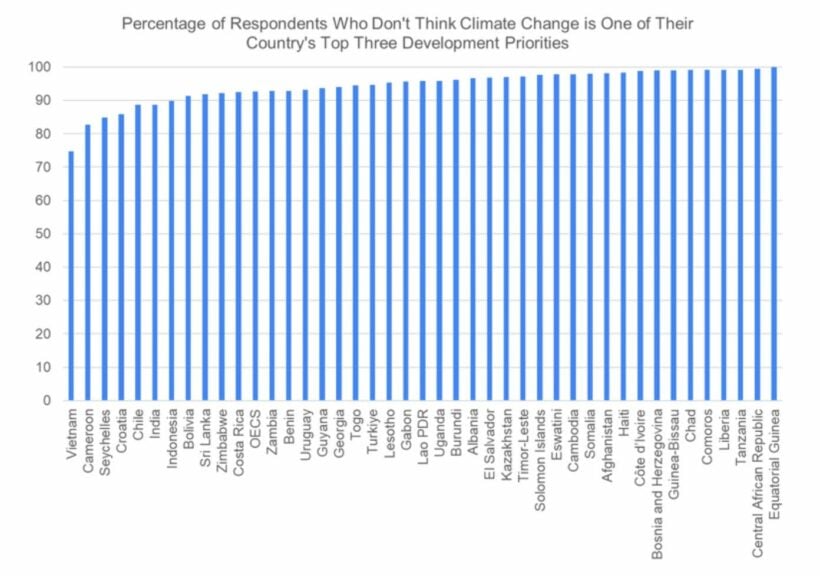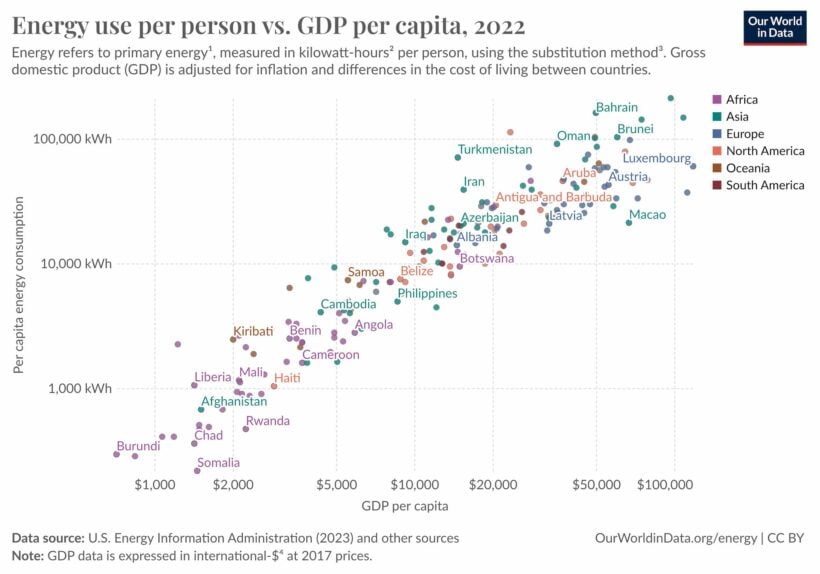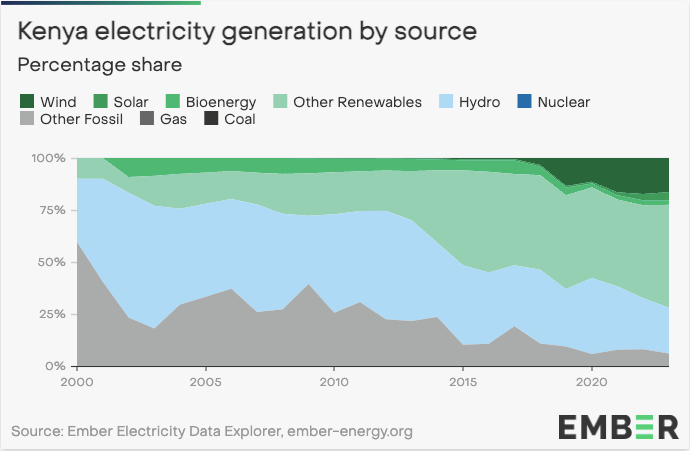Instead of merely externalizing high-income countries’ policy priorities (especially mitigation), focus should be on promoting energy access for rapid growth and adaptation.
I: Two things can be true at the same time about climate change: low-income countries need growth and adaptation; high-income countries must reduce emissions stat
As an estimated 50,000 people gather in Baku for COP29 (at which delegates hope to converge on concrete guidelines for climate finance), it’s important to highlight a few things about the political economy of climate change and development.
I’ve long maintained that policymakers in low-income countries and their partners within the global development community (donors, IFIs, the UN, policy experts, etc) are fluffing it on climate change. The inherent policy extraversion among low-income country elites as well as private interests mean that they are open to any and all climate policies that come with access to fungible cash (many also naively trust that the hawkers of “best practice” climate policy know what they are doing). Consequently, there’s very little clear thinking regarding the tradeoffs that come with trying to engineer rapid economic growth and development in an era of climate change. It doesn’t help that almost the entire international development community views the problem of climate change purely from the perspective of high-income countries. The focus tends to be on reducing emissions. There are a few vocal heretics. But most people choose (for careerist reasons) to falsify their preferences.
The net effect of these sets of actors, their motivations, and incentives is that emerging climate policies in low-income countries are invariably going to lock in ideas and practices that are anti-growth and anti-development.
Elites in low-income countries are eager to play games with the growing financialization of climate mitigation (fuzzy and fungible “green financing” or “carbon swaps” anyone?); while agenda setters at IFIs, donor agencies, and global philanthropies are busy bullying low-income countries (through both ideational hegemony and program cash incentives) to spend scarce time and money on expensive mitigation strategies instead of focusing on growth and adaptation. Consider a recent example from the Annual Meetings of the World Bank and IMF highlighted by Todd Moss:
That these busy public officials, with many deep development needs back home, bothered to fly all the way to Washington and waste precious time & effort creating a decarbonization plan for foreigners is tragic. That all the wealthy donor agencies seem to think this is all fine & normal is, frankly, obscene.
Even if you think it’s probably good for all countries to have a decarb plan, this seems unnecessary because São Tomé & Príncipe’s carbon footprint is equivalent to… about 9,500 Americans.
Let’s be blunt. It makes no sense for the World Bank, other IFIs, and donors to essentially coerce desperately poor countries like São Tomé and Principe to waste scarce time and resources on decarbonization.

Trends in per capita greenhouse gas emissions. Notice that, at least according to these data, per capita emissions in Africa peaked in the 1950s and have been declining since. Source: Our World in Data
The case of São Tomé and Principe is replicated multiple times across the Continent and in other low-income regions of the world. It also confirms a worry I expressed over a year ago when it became clear that the World Bank — and the global development community in general — was gravitating towards climate as a major focus area. Given the prevailing dominant approaches to “doing development”, it was ineluctable that the quest for “climate solutions” as a global public good would merely externalize the priorities of high-income countries (emissions reductions) and not those of low-income countries (growth and adaptation). This is already clear in the research, flows of project cash, policy directives, and general discourse. While policymakers share the blame for allowing themselves to be taken for a ride without a care for their own energy policies, it is also true that individually they have very little wriggle room in terms of setting the agenda.

Share of survey respondents (government, aid agencies, media, academia, the private sector, and civil society) that don’t consider climate change to be a top 3 priority. Source: Kenny and Ramachandran.
Let’s get the facts straight about climate change and economic development. Poverty is bad for the environment and isn’t a viable climate strategy. The vast majority of policymakers in low-income countries rightly don’t consider climate mitigation to be a top priority (we can’t hide from this fact). Energy poverty is bad for growth/development (there is no such thing as a low-energy high-income society). Low-income countries, especially on the Continent, account for a tiny share of global emissions. In the grand scheme of things, higher energy consumption due to economic growth in these countries will barely increase total global emissions. Throwing lots of money and fly-by-night expertise at mitigation (as opposed to growth and adaptation) will appreciably worsen energy policies in low-income countries (incentives matter). Misguided energy policies can severely depress economy performance (see Nigeria, Kenya, South Africa, Germany, and the United Kingdom).

There are no low-energy high-income countries. Source: Our World in Data
It also goes without saying that policy prescriptions should be sensitive to regional variation and cross-national energy markets. For example, while coal accounts for about 25% of power generation in the region, 82% of that comes from South Africa alone. Similarly, gas may account for 42% of the regional total, but in reality most of this is concentrated in Egypt, Algeria, and Nigeria (although recent gas discoveries mean greater reliance on gas by more countries). Therefore, to the extent that anyone would be interested in a real shift towards cleaner energy sources, the focus should be on working with the region’s energy heavyweights to begin the process of cleaning up — subject to the constraint of ensuring reliable energy access for growth. In addition, there are countries like Kenya and Ethiopia (and potentially the DRC — the GRAND INGA dream lives on!) with access to renewable energy sources that could potentially power entire regions if only there were reliable distribution infrastructure and policy coordination. It would seem like working on these solutions would be a better use of everyone’s time than trying to decarbonize São Tomé and Principe.

Finally, as high-income countries keep flouting their commitments to reduce emissions and to finance climate investments (e.g., adaptation, loss & damage, technology transfer, and mitigation), it’s imperative that low-income countries grow as fast as they can as soon as possible in order to afford the adaptations required to withstand climate change (the effects of which are already here).
It’s true that man-made climate change is real, and we should do everything in our power to mitigate global greenhouse emissions. However, it’s unconscionable that anyone with knowledge of the facts would make it their mission to bully aid-dependent low-income countries to spend scarce resources trying to decarbonize. No one should be allowed to be willfully ignorant of the real priorities of low-income countries: growth and adaptation. Stated differently, the bar that any mitigation/decarbonization projects must scale is that they must be both pro-growth and reasonably cost effective relative to legacy energy projects.
II: What should the World Bank and other IFIs be doing about climate change?
First and foremost, donors and IFIs shouldn’t bully low-income countries into borrowing money to save the planet. At a time when many are facing a protracted fiscal squeeze, these countries should be using all the fiscal space available to invest in growth and climate adaptation. Beyond the standard public goods and services, they also need investments in climate-resilient infrastructure, housing stock, agricultural practices, etc. Here, Ramachandran is absolutely spot on:
[L]ow-income countries are already burdened by unsustainable levels of debt, and climate finance misallocation only exacerbates this problem. Many of these countries are taking on new loans for mitigation projects—such as renewable energy or emission reduction technologies—that, while important globally, are less relevant to their immediate needs. Mitigation spending on its own is not likely to deliver the infrastructure and social services necessary to meet urgent development goals and may also strain national budgets. In Africa alone, external debt stands at $1.15 trillion, with $163 billion in debt servicing expected in 2024. MDBs must stop pushing vulnerable nations into further debt for projects that do not address their immediate climate and development needs.
Second, there’s an urgent need to rationalize climate programming in international development. In many wars, “climate change” has become yet another faddist black hole that is sucking in huge amounts of scarce resources at the expense of potentially more impactful interventions. The theatrics of doing something about climate change have become ends in themselves. Consider this:
Researchers examined 2,554 projects between 2000 and 2022 that the World Bank includes in its climate portfolio, including 2,047 projects tagged specifically as climate mitigation.
The researchers found that several hundred projects tagged as “climate mitigation”—many in poorer countries—appear to have little to do with climate change mitigation, and note that “a plain reading of project documents sheds no light on why they are labeled as climate change projects.” The study states that “this ambiguity in labeling is particularly problematic for climate mitigation, which ought to be linked directly to quantifiable emissions reduction.”
Many of the projects tagged as climate mitigation are related to health, education, and other sectors. Examples include loans for improving municipal transparency in Gaza, improving teaching at higher education institutions in Mexico, and increasing women and adolescent girls’ empowerment and their access to quality reproductive, child and maternal health services in Chad.
Here, the World Bank is merely channeling the behavior of its most influential shareholders (in terms of funding and outlook of the agenda-setting personnel within the World Bank hierarchy). This Reuters story says it all:
Italy helped a retailer open chocolate and gelato stores across Asia. The United States offered a loan for a coastal hotel expansion in Haiti. Belgium backed the film “La Tierra Roja,” a love story set in the Argentine rainforest. And Japan is financing a new coal plant in Bangladesh and an airport expansion in Egypt.
Funding for the five projects totaled $2.6 billion, and all four countries counted their backing as so-called “climate finance” – grants, loans, bonds, equity investments and other contributions meant to help developing nations reduce emissions and adapt to a warming world. Developed nations have pledged to funnel a combined total of $100 billion a year toward this goal, which they affirmed during climate talks in Paris in 2015.
These games must stop. Again, man-made climate change is real and its effects are already here. Hundreds of millions of people will be impacted by choices made about energy access and adaptation strategies. Given the stakes, it’s not too much to ask for a certain level of seriousness from those setting the programmatic agenda on the issue. At a minimum, any climate policies pushed on low-income must reflect their current energy and adaptation needs. Full stop.
Third, the development community needs to resolves its dictator’s information problem when it comes to climate change. In addition to the standard problems of faddist group think and virtue signaling, the fear of being labeled a climate truther has gotten in the way of clear thinking regarding climate and development. It should be a no-brainer that climate mitigation and adaptation strategies should differ across countries conditional on their income levels. We shouldn’t lie to ourselves that mitigation strategies will be “cheaper” in low-income countries when all we’ll be doing is limiting their access to affordable energy for growth. At this point in time, anyone interested in mitigation should singularly focus their energies on high-income countries (especially emissions and technology transfer). Of course low-income countries can adopt green energy sources too (and many already are in contexts that make sense), but only if they pass the at reasonable costs and must be pro-growth test.
Fourth, there’s a lot yet to be learned about the political economies of climate policies in low-income states. For example, are we supposed to pretend that countries pledging to protect forests in return for loans will (a) honor their pledges/ not be swindled by their creditors or (b) prudently use the fungible cash borrowed? What are we to make of desperate aid-dependent countries joining opaque climate finance schemes? How about the risk of greenwashing? Who will be left holding the bag when the dust settles? How should domestic politics and appreciation of trade-offs inform our policy prescriptions? To go back to Moss’s example, does it matter what the citizens of São Tomé and Principe think about decarbonization/energy security?
III: Conclusion
Moving forward, the current climate financing patterns and policy prescriptions will look even more ridiculous in the context of likely shifts in American and European energy policy. It won’t just be the usual problem of not honoring financing commitments. I suspect the United States to lead a number of high-income countries in the push away from decarbonization in the name of energy security and economic growth. Under these conditions, will the development community stick to business as usual vis-a-vis low-income countries?
In the final analysis, climate policy in low-income countries (like in all places) must balance energy access for rapid growth and development against concerns about emissions. The avoidance of this simple reality produces all sorts of faddist games — like the ridiculous notion that São Tomé and Principe should have a decarbonization strategy. These games must stop.
Happy COP29!!!

